Optimal Perturbations of an Oceanic Vortex Lens
Abstract
:1. Introduction
1.1. Meddies
1.2. Optimal Perturbations
2. Methods
2.1. Adjoint Methods
2.2. The Numerical Models
2.3. Parameterisation of the Vortex Lens
3. Results
3.1. Growth Rates of the Optimal Perturbations
3.2. Spatial Structure of the Optimal Perturbations
3.2.1. Horizontal Structure
3.2.2. Vertical Structure
3.3. Evolution of the Optimal Perturbations in the Non Linear Model
4. Discussion and Summary
Author Contributions
Funding
Acknowledgments
Conflicts of Interest
References
- Dugan, J.P.; Mied, R.P.; Mignerey, P.C.; Schuetz, A.F. Compact, intrathermocline eddies in the Sargasso Sea. J. Geophys. Res. 1982, 87, 385–393. [Google Scholar] [CrossRef]
- McWilliams, J.C. Submesoscale, Coherent Vortices in the Ocean. Rev. Geophys. 1985, 23, 165. [Google Scholar] [CrossRef]
- Armi, L.; Zenk, W. Large lenses of highly saline Mediterranean water. J. Phys. Oceanogr. 1984, 14, 1560–1576. [Google Scholar] [CrossRef]
- Rossby, T. Five drifters in a Mediterranean salt lens. Deep Sea Res. Part A Oceanogr. Res. Pap. 1988, 35, 1653–1663. [Google Scholar] [CrossRef]
- Pingree, R.D.; Le Cann, B. Structure of a meddy (Bobby 92) southeast of the Azores. Deep Sea Res. Part I Oceanogr. Res. Pap. 1993, 40, 2077–2103. [Google Scholar] [CrossRef]
- Senjyu, T.; Ishimaru, T.; Matsuyama, M.; Koike, Y. High salinity lens from the Strait of Hormuz. In Offshore Environments of the ROPME after the War Related Oil-Spill; Terra Scientific Publishing Company: Tokyo, Japan, 1998; pp. 35–48. [Google Scholar]
- L’Hégaret, P.; Lacour, L.; Carton, X.; Roullet, G.; Baraille, R.; Corréard, S. A seasonal dipolar eddy near Ras Al Hamra (Sea of Oman). Ocean Dyn. 2013, 63, 633–659. [Google Scholar] [CrossRef]
- L’Hégaret, P.; Carton, X.; Louazel, S.; Boutin, G. Mesoscale eddies and submesoscale structures of Persian Gulf Water off the Omani coast in spring 2011. Ocean Sci. 2016, 12, 687–701. [Google Scholar] [CrossRef]
- Shapiro, G.I.; Meschanov, S.L. Distribution and spreading of Red Sea Water and salt lens formation in the northwest Indian Ocean. Deep Sea Res. Part A Oceanogr. Res. Pap. 1991, 38, 21–34. [Google Scholar] [CrossRef]
- Meschanov, S.L.; Shapiro, G.I. A young lens of Red Sea Water in the Arabian Sea. Deep Sea Res. Part I Oceanogr. Res. Pap. 1998, 45, 1–13. [Google Scholar] [CrossRef]
- D’Asaro, E.A. Generation of submesoscale vortices: A new mechanism. J. Geophys. Res. 1988, 93, 6685–6693. [Google Scholar] [CrossRef]
- Baird, M.E.; Ridgway, K.R. The southward transport of sub-mesoscale lenses of Bass Strait Water in the centre of anti-cyclonic mesoscale eddies. Geophys. Res. Lett. 2012, 39, L02603. [Google Scholar] [CrossRef]
- Meunier, T.; Tenreiro, M.; Pallàs-Sanz, E.; Ochoa, J.; Ruiz-Angulo, A.; Portela, E.S.C.; Damien, P.; Carton, X. Intra-Thermocline Eddies Embedded within an Anticyclonic Vortex Ring. Geophys. Res. Lett. 2018. [Google Scholar] [CrossRef]
- Morel, Y.; McWilliams, J. Effects of Isopycnal and Diapycnal Mixing on the Stability of Oceanic Currents. J. Phys. Oceanogr. 2001, 31, 2280–2296. [Google Scholar] [CrossRef]
- Carton, X.; Chérubin, L.; Paillet, J.; Morel, Y.; Serpette, A.; Le Cann, B. Meddy coupling with a deep cyclone in the Gulf of Cadiz. J. Mar. Syst. 2002, 32, 13–42. [Google Scholar] [CrossRef]
- Paillet, J.; Le Cann, B.; Carton, X.; Morel, Y.; Serpette, A. Dynamics and evolution of a northern meddy. J. Phys. Oceanogr. 2002, 32, 55–79. [Google Scholar] [CrossRef]
- Ruddick, B.; Hebert, D. The mixing of meddy “sharon”. In Small-Scale Turbulence and Mixing in the Ocean; Elsevier: New York, NY, USA, 1988; Volume 46, pp. 249–261. [Google Scholar]
- Armi, L.; Hebert, D.; Oakey, N.; Price, J.F.; Richardson, P.L.; Rossby, H.T.; Ruddick, B. Two years in the life of a Mediterranean salt lens. J. Phys. Oceanogr. 1989, 19, 354–370. [Google Scholar] [CrossRef]
- Schultz-Tokos, K.; Rossby, T. Kinematics and Dynamics of a Mediterranean Salt Lens. J. Phys. Oceanogr. 1991, 21, 879–892. [Google Scholar] [CrossRef] [Green Version]
- Biescas, B.; Sallarès, V.; Pelegrí, J.L.; Machín, F.; Carbonell, R.; Buffett, G.; Dañobeitia, J.J.; Calahorrano, A. Imaging meddy finestructure using multichannel seismic reflection data. Geophys. Res. Lett. 2008, 35, 11609. [Google Scholar] [CrossRef]
- Hua, B.L.; Ménesguen, C.; Le Gentil, S.; Schopp, R.; Marsset, B.; Aiki, H. Layering and turbulence surrounding an anticyclonic oceanic vortex: In Situ observations and quasi-geostrophic numerical simulations. J. Fluid Mech. 2013, 731, 418–442. [Google Scholar] [CrossRef]
- Ruddick, B. Intrusive mixing in a Mediterranean salt lens-intrusion slopes and dynamical mechanisms. J. Phys. Oceanogr. 1992, 22, 1274–1285. [Google Scholar] [CrossRef]
- Song, H.; Pinheiro, L.M.; Ruddick, B.; Teixeira, F.C. Meddy, spiral arms, and mixing mechanisms viewed by seismic imaging in the Tagus Abyssal Plain (SW Iberia). J. Mar. Res. 2011, 69, 4–6. [Google Scholar] [CrossRef]
- Meunier, T.; Ménesguen, C.; Schopp, R.; Le Gentil, S. Tracer Stirring around a Meddy: The Formation of Layering. J. Phys. Oceanogr. 2015, 45, 407–423. [Google Scholar] [CrossRef]
- Nguyen, H.Y.; Hua, B.L.; Schopp, R.; Carton, X. Slow quasigeostrophic unstable modes of a lens vortex in a continuously stratified flow. Geophys. Astrophys. Fluid Dyn. 2012, 106, 305–319. [Google Scholar] [CrossRef]
- Carton, X.; Sokolovskiy, M.; Ménesguen, C.; Aguiar, A.; Meunier, T. Vortex stability in a multi-layer quasi-geostrophic model: Application to Mediterranean Water eddies. Fluid Dyn. Res. 2014, 46, 061401. [Google Scholar] [CrossRef]
- Haynes, P.; Anglade, J. The vertical-scale cascade in atmospheric tracers due to large-scale differential advection. J. Atmos. Sci. 1997, 54, 1121–1136. [Google Scholar] [CrossRef]
- Klein, P.; Treguier, A.M.; Hua, B.L. Three-dimensional stirring of thermohaline fronts. J. Mar. Res. 1998, 56, 589–612. [Google Scholar] [CrossRef]
- Flierl, G.R. Models of vertical structure and the calibration of two-layer models. Dyn. Atmos. Oceans 1978, 2, 341–381. [Google Scholar] [CrossRef]
- McWilliams, J.C.; Flierl, G.R. On the evolution of isolated, nonlinear vortices. J. Phys. Oceanogr. 1979, 9, 1155–1182. [Google Scholar] [CrossRef]
- Carton, X.J. On the merger of shielded vortices. Europhys. Lett. 1992, 18, 697. [Google Scholar] [CrossRef]
- McWilliams, J.C.; Gent, P.R. The evolution of sub-mesoscale, coherent vortices on the -plane. Geophys. Astrophys. Fluid Dyn. 1986, 35, 235–255. [Google Scholar] [CrossRef]
- Yim, E.; Billant, P. On the mechanism of the Gent-McWilliams instability of a columnar vortex in stratified rotating fluids. J. Fluid Mech. 2015, 780, 5–44. [Google Scholar] [CrossRef] [Green Version]
- Farrell, B.F. The Initial Growth of Disturbances in a Baroclinic Flow. J. Atmos. Sci. 1982, 39, 1663–1686. [Google Scholar] [CrossRef] [Green Version]
- Farrell, B.F.; Ioannou, P.J. Generalized Stability Theory. Part I: Autonomous Operators. J. Atmos. Sci. 1996, 53, 2025–2040. [Google Scholar] [CrossRef] [Green Version]
- Talagrand, O.; Courtier, P. Variational assimilation of meteorological observations with the adjoint vorticity equation. I: Theory. Q. J. R. Meteorol. Soc. 1987, 113, 1311–1328. [Google Scholar] [CrossRef]
- Buizza, R.; Tribbia, J.; Molteni, F.; Palmer, T. Computation of optimal unstable structures for a numerical weather prediction model. Tellus Ser. A 1993, 45, 388. [Google Scholar] [CrossRef]
- Hartmann, D.L.; Buizza, R.; Palmer, T.N. Singular Vectors: The Effect of Spatial Scale on Linear Growth of Disturbances. J. Atmos. Sci. 1995, 52, 3885–3894. [Google Scholar] [CrossRef] [Green Version]
- Moore, A.M.; Farrell, B.F. Rapid Perturbation Growth on Spatially and Temporally Varying Oceanic Flows Determined Using an Adjoint Method: Application to the Gulf Stream. J. Phys. Oceanogr. 1993, 23, 1682–1702. [Google Scholar] [CrossRef] [Green Version]
- Rivière, G.; Hua, B.L.; Klein, P. Influence of the β-effect on non-modal baroclinic instability. Q. J. R. Meteorol. Soc. 2001, 127, 1375–1388. [Google Scholar] [CrossRef]
- Nolan, D.S.; Farrell, B.F. Generalized Stability Analyses of Asymmetric Disturbances in One- and Two-Celled Vortices Maintained by Radial Inflow. J. Atmos. Sci. 1999, 56, 1282–1307. [Google Scholar] [CrossRef]
- Yamaguchi, M.; Nolan, D.S.; Iskandarani, M.; Majumdar, S.J.; Peng, M.S.; Reynolds, C.A. Singular Vectors for Tropical Cyclone-Like Vortices in a Nondivergent Barotropic Framework. J. Atmos. Sci. 2011, 68, 2273–2291. [Google Scholar] [CrossRef]
- Carton, X.; Flierl, G.R.; Perrot, X.; Meunier, T.; Sokolovskiy, M.A. Explosive instability of geostrophic vortices. Part 1: Baroclinic instability. Theor. Comput. Fluid Dyn. 2010, 24, 125–130. [Google Scholar] [CrossRef]
- Farrell, B.F.; Moore, A.M. An Adjoint Method for Obtaining the Most Rapidly Growing Perturbation to Oceanic Flows. J. Phys. Oceanogr. 1992, 22, 338. [Google Scholar] [CrossRef]
- Farrell, B.F. Optimal Excitation of Baroclinic Waves. J. Atmos. Sci. 1989, 46, 1193–1206. [Google Scholar] [CrossRef] [Green Version]
- Gubernatis, J.E.; Booth, T.E. Multiple extremal eigenpairs by the power method. J. Comput. Phys. 2008, 227, 8508–8522. [Google Scholar] [CrossRef] [Green Version]
- Hua, B.L.; Haidvogel, D.B. Numerical simulations of the vertical structure of quasi-geostrophic turbulence. J. Atmos. Sci. 1986, 43, 2923–2936. [Google Scholar] [CrossRef]
- Fruman, M.; Achatz, U. Secondary instabilities in breaking inertia-gravity waves. In Proceedings of the EGU General Assembly Conference Abstracts, Vienna, Austria, 2–7 May 2010; Volume 12, p. 10232. [Google Scholar]
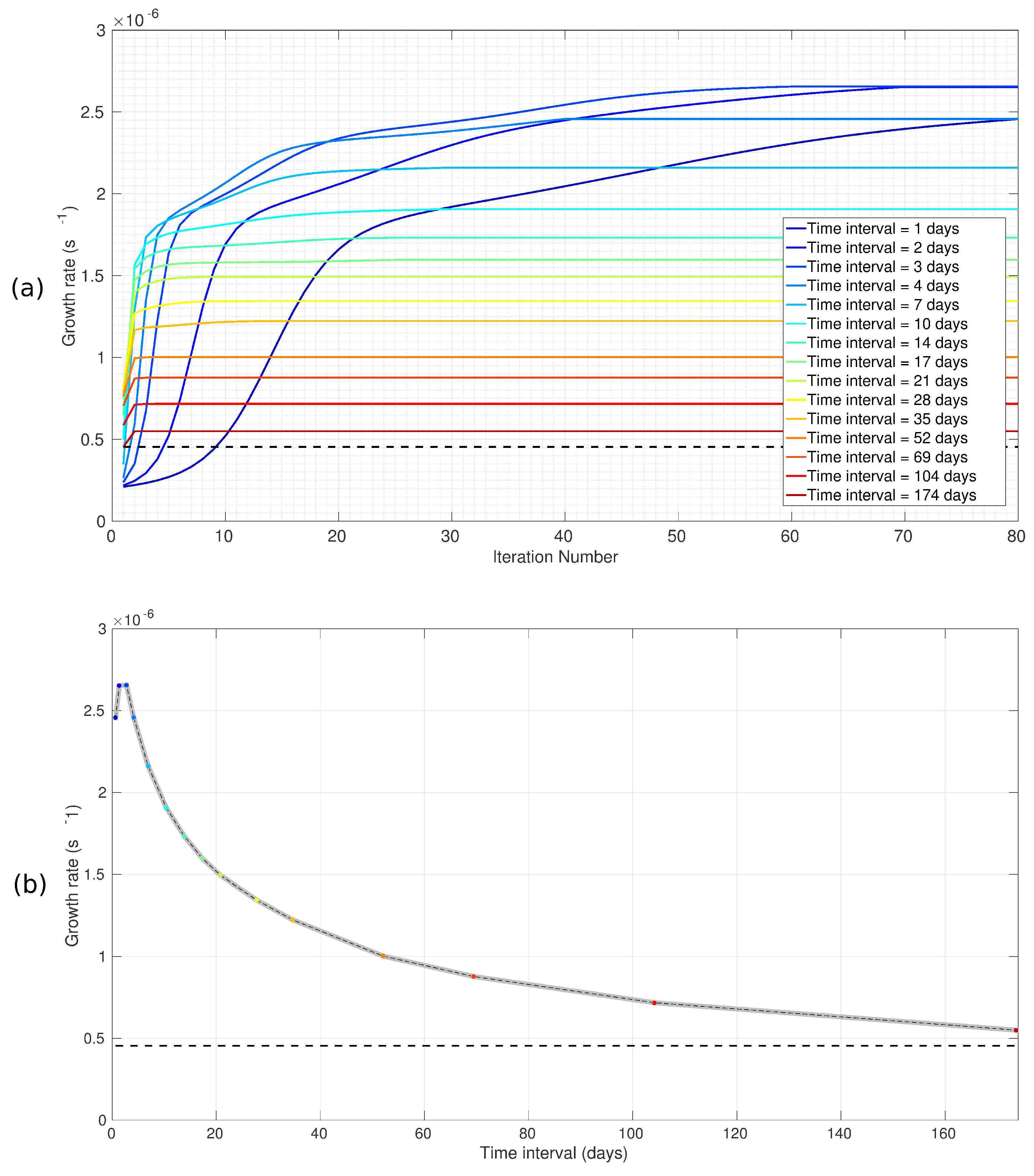



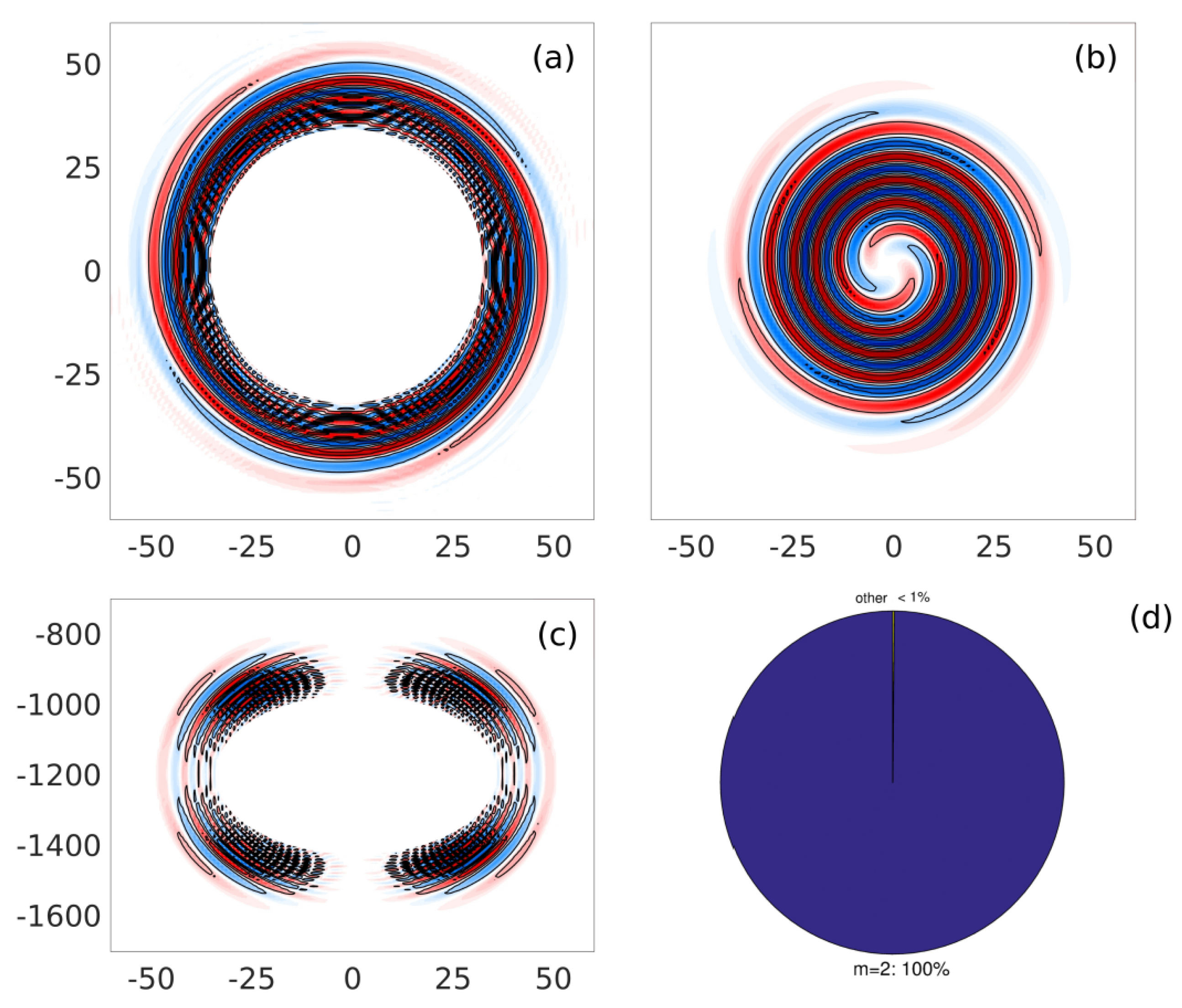
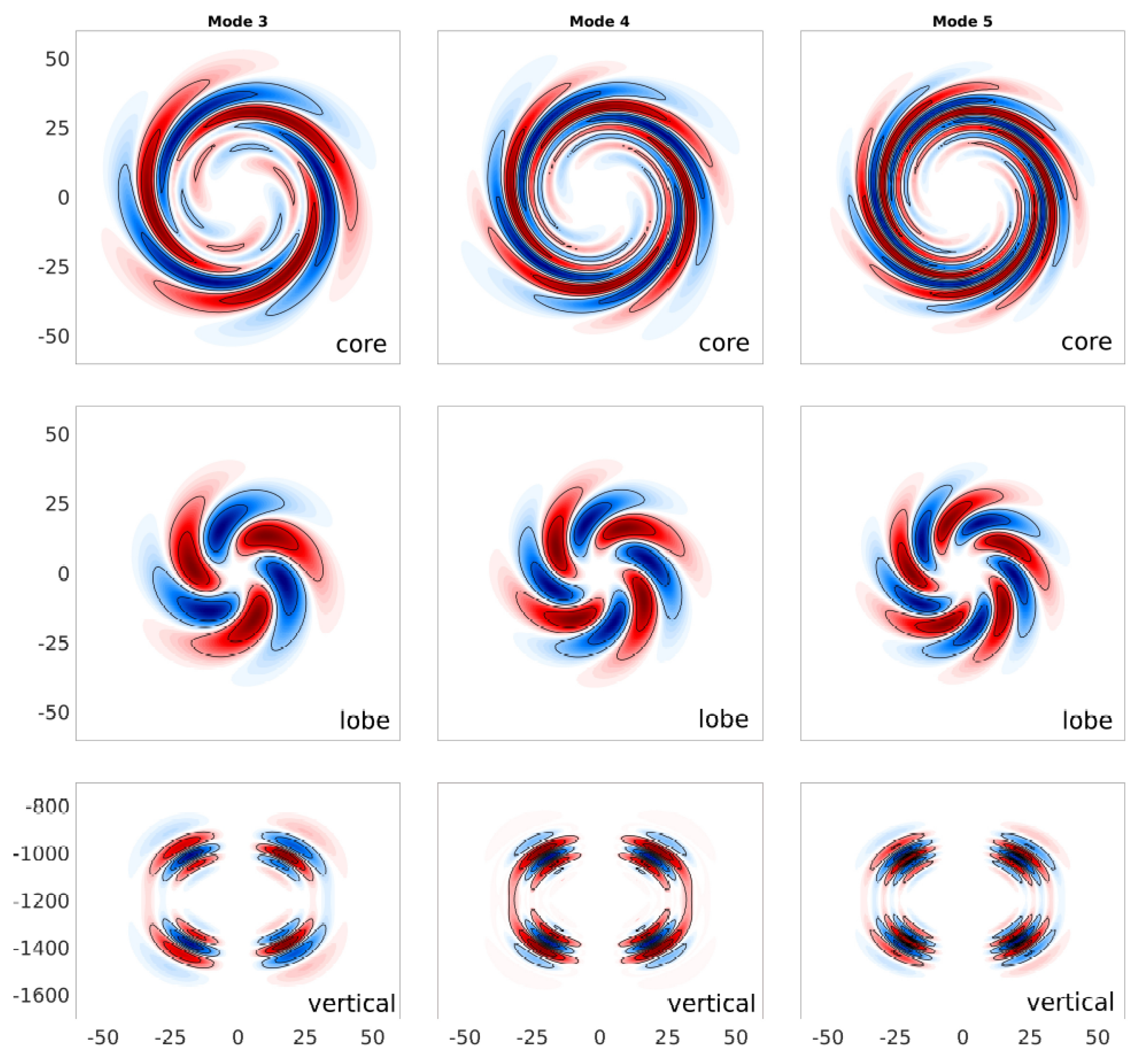
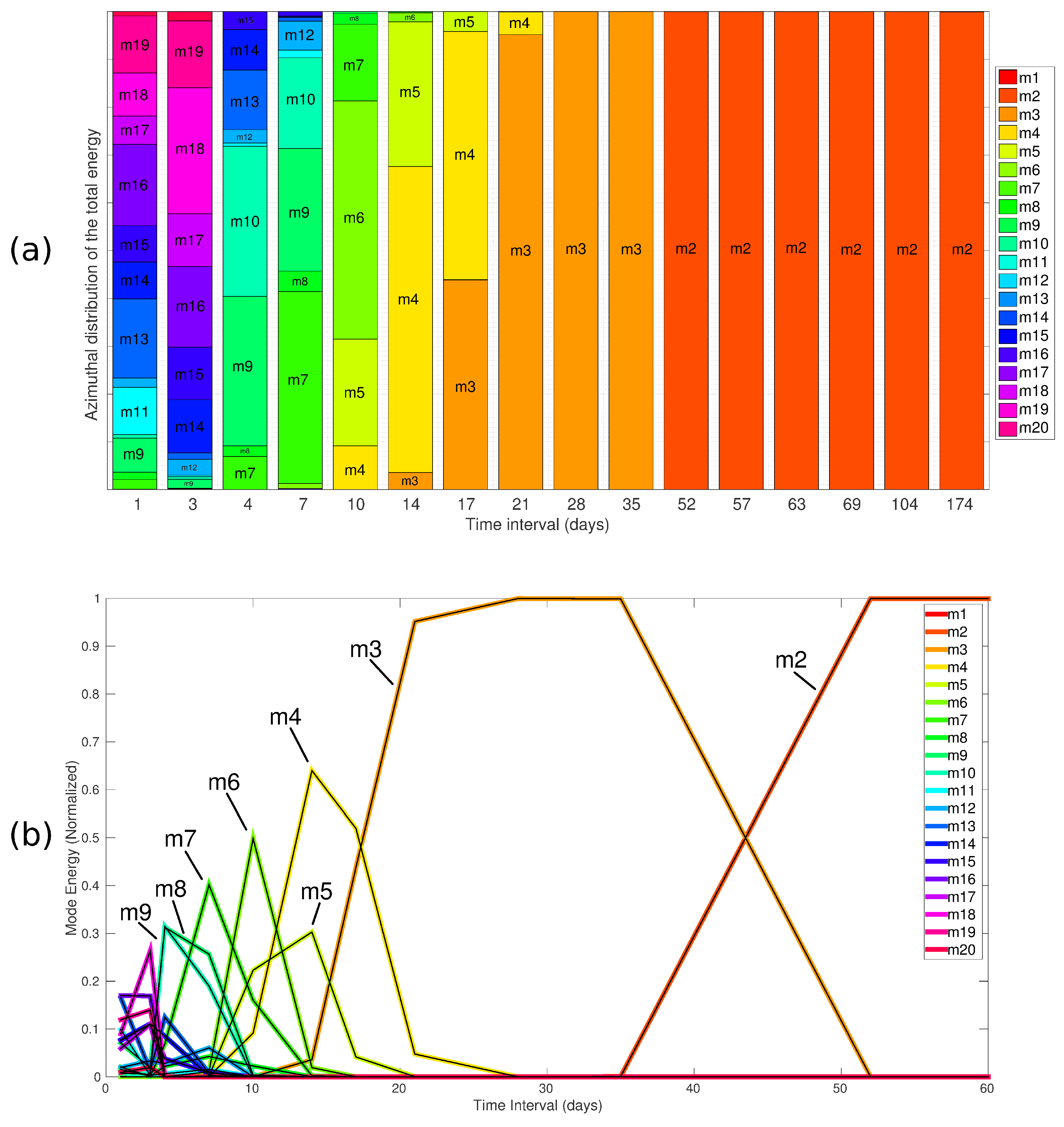
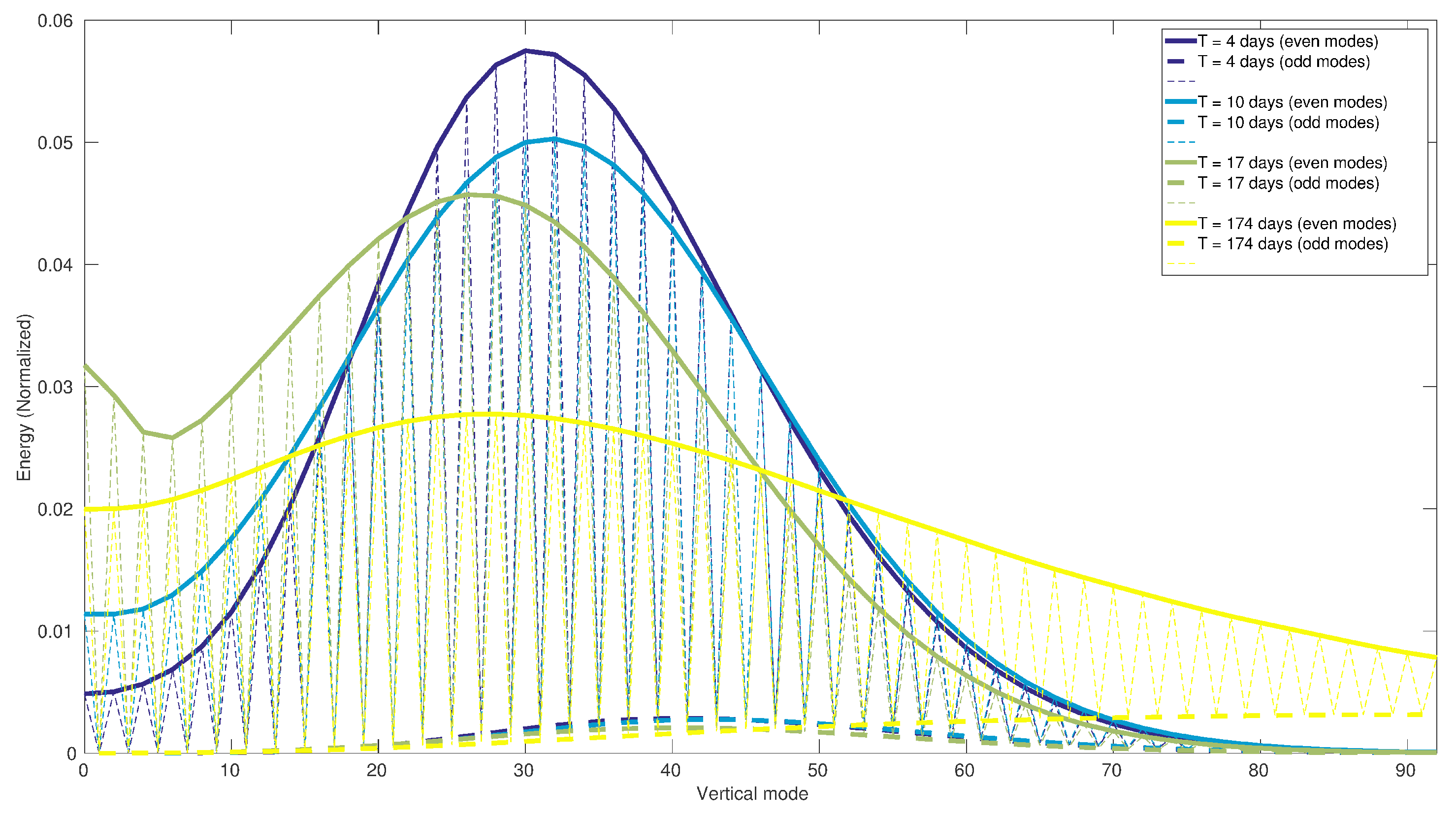

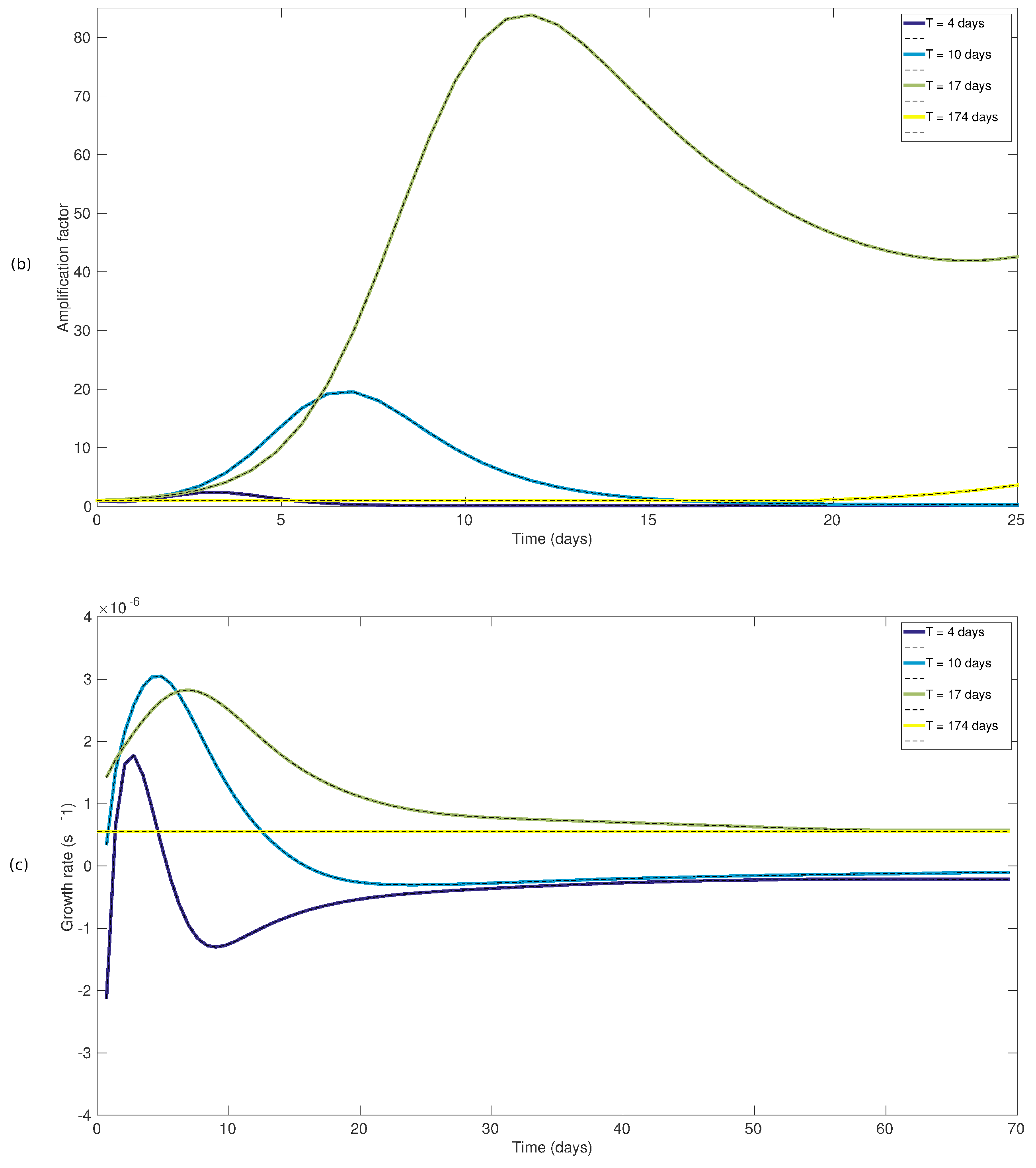
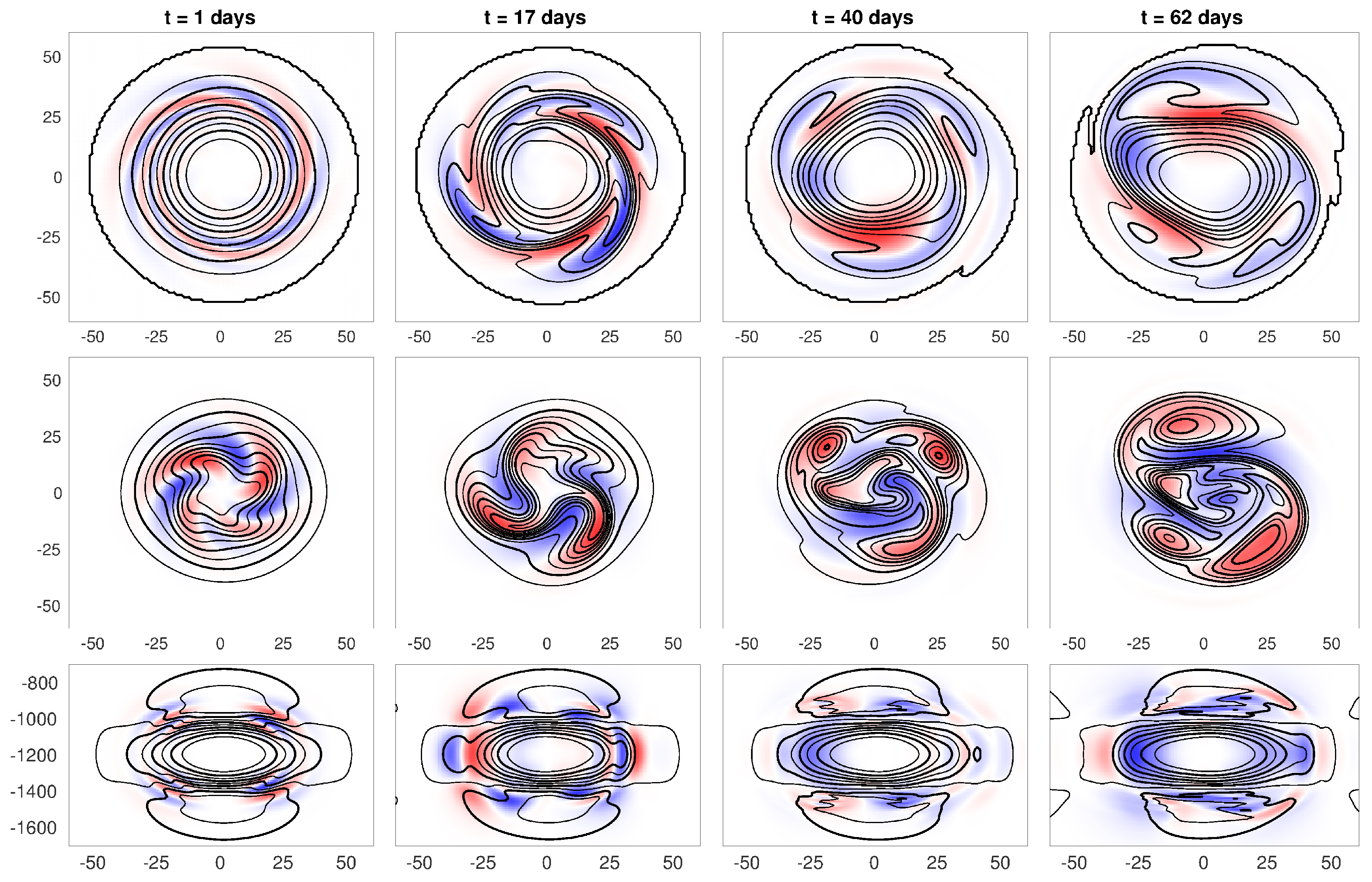
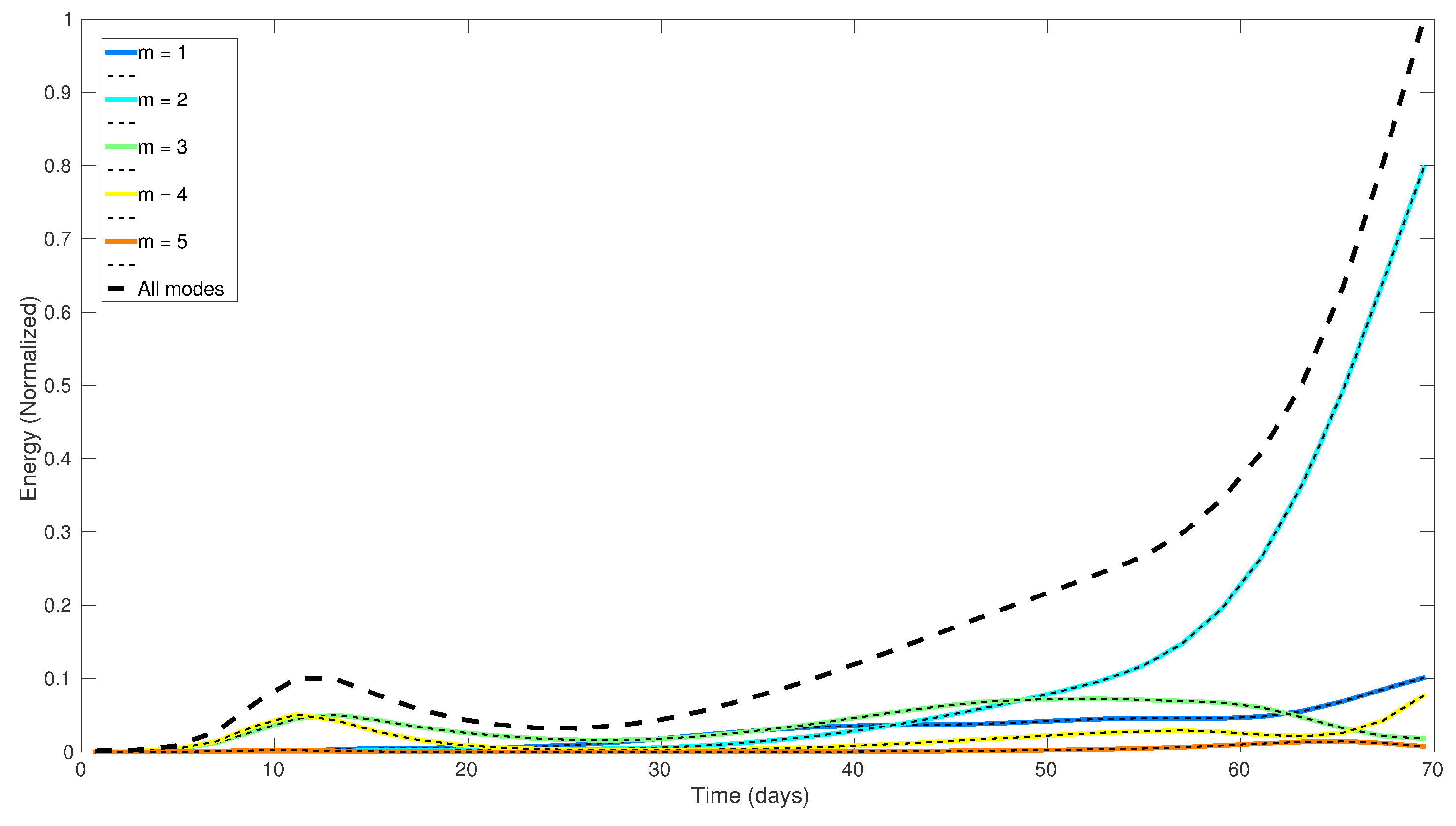
© 2018 by the authors. Licensee MDPI, Basel, Switzerland. This article is an open access article distributed under the terms and conditions of the Creative Commons Attribution (CC BY) license (http://creativecommons.org/licenses/by/4.0/).
Share and Cite
Meunier, T.; Ménesguen, C.; Carton, X.; Le Gentil, S.; Schopp, R. Optimal Perturbations of an Oceanic Vortex Lens. Fluids 2018, 3, 63. https://doi.org/10.3390/fluids3030063
Meunier T, Ménesguen C, Carton X, Le Gentil S, Schopp R. Optimal Perturbations of an Oceanic Vortex Lens. Fluids. 2018; 3(3):63. https://doi.org/10.3390/fluids3030063
Chicago/Turabian StyleMeunier, Thomas, Claire Ménesguen, Xavier Carton, Sylvie Le Gentil, and Richard Schopp. 2018. "Optimal Perturbations of an Oceanic Vortex Lens" Fluids 3, no. 3: 63. https://doi.org/10.3390/fluids3030063




